
Tesseracts Thirteen
Ed. by Nancy Kilpatrick and David Morrell
EDGE Publishing, 2009
Annual Canadian anthology Tesseracts, until this collection supplying readers with quality science fiction, in the issue number 13 turned into an anthology of horror and dark fantasy. It might have been expected just by looking at the names of the editors: Nancy Kilpatrick, author of many vampire novels, and Morrell who is not just the author of "First Blood" and the literary father of Rambo, but also a writer, who wrote lots of thrillers with elements of horror.
What Canadian horror writers distinguished in comparison with their colleagues from the United States or Britain to the better side is a gentle approach to the description of the heroes of the story. This collection is inhabited not by the rough casts of characters, not the outline, but full, with the backgrounds and believable motives, characters.
However, solving this problem, many authors of the anthology couldn’t not solve the other, just no less important: to put the characters in such story, in which character’s three-dimensionality would have helped to the creation of three-dimensionality of the described world, where characters are placed. Most of the stories, having good inclinations, did not turn into something extraordinary. In the «Stone Cold» Kevin Cockle realistically described life of invalid, who also always feels a chill - he never gets warm. Unfortunately, behind a description of everyday life the story is lost: it seems get frozen together with the hero. The story of Rebecca Bradley «Kids These Days» has absolutely charming beginning: in the described world, children have lost all the life skills, something struck their brain: they can not themselves move or drink, or even respond to anything threatening their lives. Parents have an extremely hard to cope with their offspring. However, a story that could have been just finished brilliantly as well, the author has brought to the unbelievable horror ending. Such problem and with Susanna Church’s. It «The Tear Closet» unfolds the story of domestic violence from the view of a little girl, but introduced element of fantasy fades from the fact that the author almost sinking her story into melodrama, with one goal - to squeeze out a tear in the reader.
The two strongest stories are in the final part of the anthology. David Nickle in «The Radejastians» doesn’t give away many, so increasing fascination of his story. The story of three men who hard to call friends arrive in another country (another planet? Author hardly gives any hints on where the story takes place: it may be an alternative Earth, and perhaps a different planet.), go to obscure work, and one of them is invited to a certain church, to compare, whether it is better than the one where he visited before (What was that another church and where it was, still unknown). This story is not about God, but about religion, about how to find themselves and then lose. Another gem of the anthology is eerie tale by Mary E. Choo «The Language of Crows». It's a strange story of the family where the husband dies and the wife remains hostage to his whims. While reading this story, crow caw actually fills your ears.
A nice addition to a very good fiction part is review of Canadian horror and fantasy, written by Robert Knowlton.
No comments:
Post a Comment